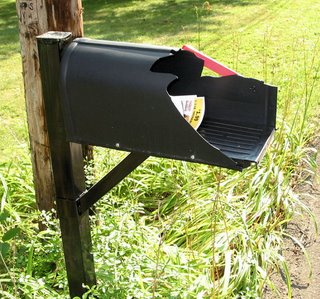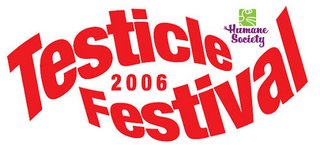[from SAPL...]
House of Representatives to Vote on a Permanent End to Horse Slaughter!
The American public must be heard like never before!
June 22, 2006
Dear Humanitarian:
Since the Society for Animal Protective Legislations national campaign against horse slaughter began in 2001, our ultimate goal has been passage of a permanent horse slaughter ban. We have just learned House of Representatives Leadership has assured the sponsors of the American Horse Slaughter Prevention Act that a vote on the measure will take place on the House floor before June 30.
Sponsored in the House by Congressional Horse Caucus Co-chair John Sweeney (R-NY), Representative John Spratt, Jr. (D-SC) and Representative Ed Whitfield (R-KY), the Act will end the slaughter of horses for human consumption and the domestic and international transport of live horses or horseflesh for the same purpose. Just last year, over 90,000 horses were slaughtered in the three foreign-owned horse slaughter facilities located in Texas and Illinois.
We have always believed that, if given a fair chance and an open vote, Congress would support this complete ban. Four separate times, it has demonstrated interest in stopping horse slaughter for wild and domestic horses by voting in favor of amendments. The upcoming vote is crucial, and it represents a culmination of five years of hard work by supporters from across the United States. It is vital for everyone you know to call their Representative immediately and urge a YES vote for the Act.
WHAT YOU CAN DO:
Please call or fax your Representative TODAY, asking him or her to vote in favor of H.R. 503, the American Horse Slaughter Prevention Act. Keep checking your email every day for the latest news, and continue to contact your Representative until the vote has transpired.
When talking with your Representative's office please include some of the additional facts about horse slaughter listed below.
To locate your Representatives contact information and to learn more about horse slaughter and the American Horse Slaughter Prevention Act please visit www.saplonline.org/horses.htm.
Please share our Dear Humanitarian eAlert with family, friends and co-workers, and encourage them to call or fax their Members of Congress, too. Thank you very much for your help!
Sincerely,
Cathy Liss
Legislative Director
Sign up for SAPL eAlerts to receive the latest legislative news on what you can do to help us protect all animals. http://www.saplonline.org/action.htm
FACTS AND FAQ's ABOUT HORSE SLAUGHTERLast year three foreign-owned slaughter plants cruelly slaughtered more than 90,000 horses for human consumption in Europe and Asia. Tens of thousands more of America's horses were exported from the U.S. and slaughtered in other countries.
Slaughter is NOT humane euthanasia. Horses suffer horribly on the way to and during slaughter.
Passage of the American Horse Slaughter Prevention Act (AHSPA) will reduce animal suffering hence its wide support throughout the equestrian and veterinary world, as well as the humane community.
Americans overwhelmingly support an end to horse slaughter for human consumption (polls from Kentucky, Virginia, Texas and Utah respectively show that 82, 74, 72 and 69 percent of those questioned oppose the practice). In California, a 1998 ballot initiative (Prop. 6) banning horse slaughter for human consumption passed with 60 percent of the vote.
Sick and old horses to slaughter Question: Is it true that slaughter is only a last resort for infirm, dangerous or no longer serviceable horses?
Answer: 92.3 percent of horses arriving at slaughter plants in this country are in "good" condition, according to the US Department of Agriculture's Guidelines for Handling and Transporting Equines to Slaughter.
Neglect and abuse Question: Will horse abuse and neglect cases rise significantly following a ban on slaughter?
Answer: There has been no documented rise in abuse and neglect cases in California since the state banned horse slaughter for human consumption in 1998. There was no documented rise in Illinois following closure of the state's only horse slaughter plant in 2002 and its reopening in 2004.
Cost of caring for unwanted horses Question: If there is a ban on horse slaughter, will horse rescue and retirement groups have the resources to take care of unwanted horses? Should the government have to pay for the care of horses voluntarily given up by their owners?
Answer: Not every horse currently going to slaughter will need to be absorbed into the rescue community many will be sold to a new owner, others will be kept longer and a licensed veterinarian will humanely euthanize some. Opponents of this legislation admit passage of the bill will not necessarily lead to an increase in the number of horses sent to rescue facilities, precisely because humane euthanasia is so widely used. It is not the government's responsibility to provide for the care of horses voluntarily given up by their owners, as these animals are private property. Hundreds of horse rescue organizations operate around the country, and additional facilities are being established (a list is available).
A safe and humane solution for sick, old and unwanted horsesQuestion: If slaughter is not an option, what will we do with sick, old and unwanted horses?
Answer: Approximately 900,000 horses die annually in this country (10 percent of an estimated population of 9 million) and the vast majority are not slaughtered, but euthanized and rendered or buried without any negative environmental impact instead. Humane euthanasia and carcass disposal is highly affordable and widely available. The average cost of having a horse humanely euthanized and safely disposing of the animal's carcass is approximately $225, while the average monthly cost of keeping a horse is approximately $200.
Export of horses for slaughter abroad Question: If there is a ban on horse slaughter in the United States, will there be an increase in the export of horses for foreign slaughter? Will horses suffer from longer transport for slaughter in countries where there may be weaker welfare laws?
Answer: Horse slaughter has declined dramatically in the United States over the past decade, but there has been no correlating increase in the number of American horses exported for slaughter abroad. Further, the AHSPA prohibits the export of horses for slaughter abroad, and contains clear enforcement and penalty provisions to prevent this from happening. Risk of federal prosecution and the high costs associated with illegally transporting horses long distances for slaughter abroad are strong deterrents.
Standards of care at sanctuaries and rescue organizations Question: Is it true no standards exist for horse rescue facilities that take unwanted horses?
Answer: The Doris Day Animal League and the Animal Welfare Institute published
"Basic Guidelines for Operating an Equine Rescue or Retirement Facility" in 2004. Additionally, the Association of Sanctuaries and the American Sanctuaries Association provide accreditation programs, a code of ethics and guidelines for the operation of sanctuaries and rescue organizations. Horse rescue groups must also provide for the welfare of horses in their custody in compliance with state and local animal welfare laws.
Use of horsemeat in pet food Question: If there is a ban on horse slaughter, will horsemeat no longer be available for pet food?
Answer: There is no horsemeat in pet food. This practice stopped decades ago and has some connection to the enactment of protections for America's wild horses in 1971. The US public and Congress were outraged to learn federal agencies were rounding up and allowing the exploitation and slaughter of these national treasures for items such as pet food. Some by-products of the horse slaughter industry are used in various consumer items, but they are derived from the rendering (a different process than slaughter and not affected by the AHSPA) of dead horses and other animals.






 Petey, who is more manageable because he's small...
Petey, who is more manageable because he's small... Pepper, who needs socialization.
Pepper, who needs socialization.
















